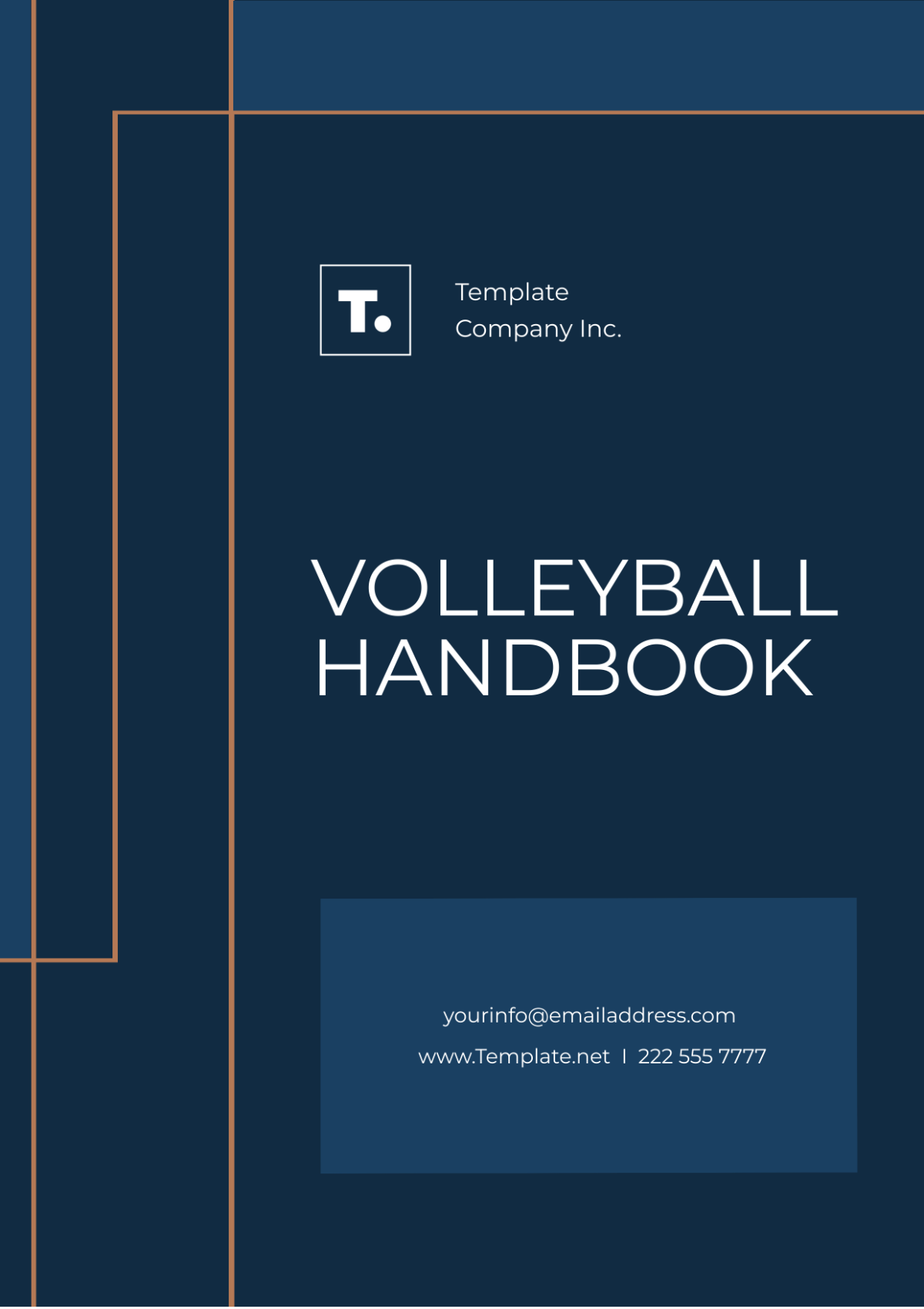Volleyball Handbook
Welcome to the [YOUR COMPANY NAME] Volleyball Handbook, designed to provide players at all levels with comprehensive guidelines on the rules of the game and best practices for playing volleyball effectively and safely.
Whether you are a beginner or an experienced player, this handbook serves as a valuable resource to understand the dynamics of the game better and improve your skills.
Compiled by [YOUR NAME], this manual ensures that all participants have ready access to the essential information needed for both training and competition. Trust that this handbook will be an indispensable tool in your volleyball journey.
I. Introduction
A. About [YOUR COMPANY NAME]
[YOUR COMPANY NAME] is dedicated to nurturing sporting talents by providing high-quality training resources and facilities. We believe in the power of sports to transform lives and are committed to the development of volleyball players across all skill levels.
Through continuous engagement with the community and emphasis on sportsmanship, [YOUR COMPANY NAME] aims to foster a positive and competitive volleyball environment. Contact us through [YOUR COMPANY EMAIL] or visit our website at [YOUR COMPANY WEBSITE] for more information.
B. Purpose of the Handbook
This handbook is crafted to serve as a central resource for understanding the basic to advanced techniques and rules of volleyball. It is meant to be a bridge between rookie enthusiasm and professional expertise, equipping all players with the knowledge needed to excel in the sport.
Suitable for self-learning or as a complement to coaching sessions, it encompasses both theoretical and practical aspects of volleyball tailored to enhance your gameplay.
II. Understanding Volleyball
A. Overview of the Game
Volleyball is a team sport that involves two teams of six players separated by a net, with the objective of sending the ball over the net to touch the opponent's court floor. Each team has three hits to return the ball.
The game demands both physical prowess and strategic planning, making it both exciting and challenging. Playing volleyball offers numerous benefits, including improving hand-eye coordination, reflexes, and overall physical conditioning.
B. Equipment and Court Specifications
The standard volleyball court is 18 meters long and 9 meters wide, divided into two equal halves by a net that stands 2.43 meters high for men and 2.24 meters for women.
Players need minimal equipment: primarily a volleyball and proper sportswear. Most organized competitions also require knee pads and volleyball shoes, which are designed to provide support and flexibility during play.
III. Fundamental Rules of Volleyball
A. Basic Rules
Teams consist of six players on the court at any time.
A point is scored when the ball contacts the floor within the opposing team's court.
Each team has a maximum of three successive contacts of the ball to return it to the opponent's court.
The ball must be hit, not caught or thrown. Players may not block or attack a serve from on or inside the 10-foot line.
Matches are typically played best 3 out of 5 sets, with the first four sets to 25 points and a potential fifth set to 15 points.
B. Officiating and Violations
Matches are generally overseen by a referee who resolves points, fouls, and disputes. Common violations include double hits, four hits, net violations, and foot faults during a serve. It is vital for players to familiarize themselves with both common and infrequent rule violations to avoid penalties and play a fair game.
IV. Advanced Techniques and Strategies
A. Serving Techniques
The service is a critical skill in volleyball as it starts each rally. Techniques include the underhand serve, overhand serve, float serve, and jump serve. Each technique has different advantages and is used based on the situation and the server’s skill level. Mastery of various serving techniques can significantly pressure the opposing team.
B. Defensive Moves
Good defense is the backbone of a successful volleyball team. Key defensive strategies include positioning, anticipation, and quick reactions. Players must master the art of digging, blocking, and court coverage to prevent the opponents from scoring. Continuous practice and game experience play indispensable roles in mastering these skills.
V. Training and Conditioning
A. Physical Conditioning
Physical fitness is crucial in volleyball. Players should engage in regular cardiovascular, strength, and flexibility training to improve their stamina, explosive power, and injury resilience. Exercises like squats, lunges, plyometric drills, and core workouts are particularly beneficial for volleyball players.
B. Practice Drills
Regular drills can help improve technique, timing, and team cohesion. Some effective volleyball drills include serving drills, setting drills, passing drills, and simulated game situations. Coaches often tailor drills to meet the needs of their team, focusing on weaknesses observed during matches.
VI. Player Safety
A. Avoiding Injuries
Injuries can be a common issue in volleyball. Players are advised to warm up and cool down properly during training and matches to prevent injuries. Attention should also be paid to proper techniques, especially during spikes and blocks where wrist, shoulder, and ankle injuries are prevalent.
Using proper protective gear and playing on safe, well-maintained courts can further mitigate injury risks.
B. Emergency Protocols
It is essential for teams to have emergency protocols in place, including access to first aid and contact information for medical professionals. Coaches and players should be trained in basic first aid and know how to act in case of injuries or other medical emergencies during games or practice.
VII. Appendix
A. Glossary of Terms
The appendix includes a glossary of volleyball-specific terms to help new players better understand the terminology used in this book. It covers terms from "Ace" to "Underhand Serve," ensuring comprehensive coverage of volleyball lexicons.
B. Contact Information
For further questions or information regarding [YOUR COMPANY NAME] volleyball activities, please contact us through the following:
Phone: [YOUR COMPANY NUMBER]
Address: [YOUR COMPANY ADDRESS]
Social Media: [YOUR COMPANY SOCIAL MEDIA]
Revision History
Date | Description | Version |
|---|
[Release Date] | Initial release | 1.0 |
[Revision Date] | [Revision Description] | [Revision Version] |
Handbook Templates @ Template.net






























